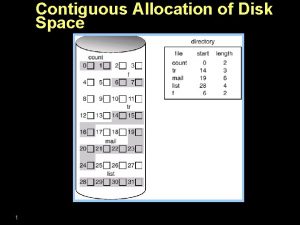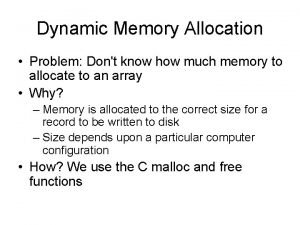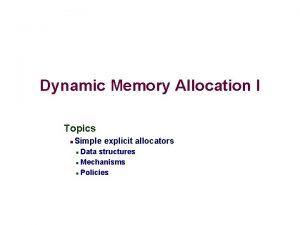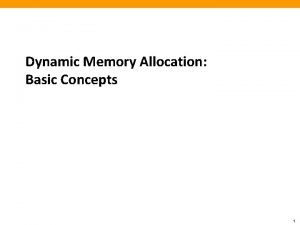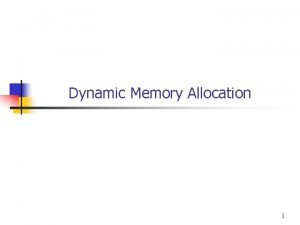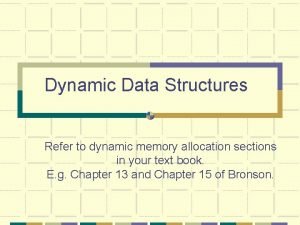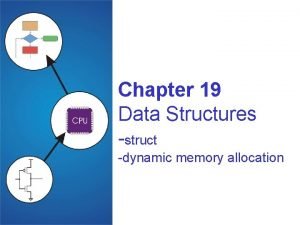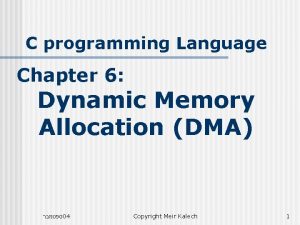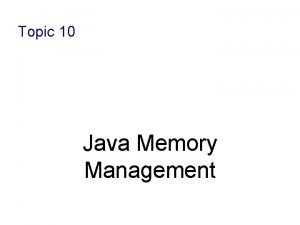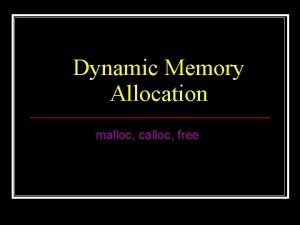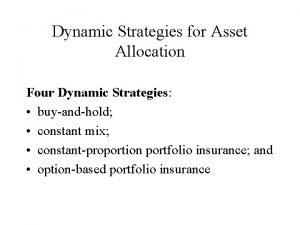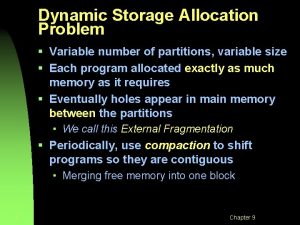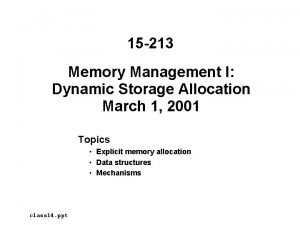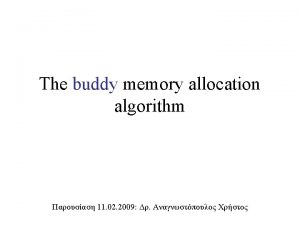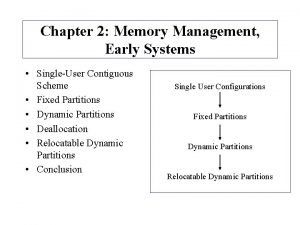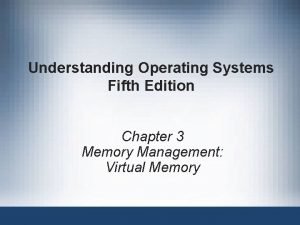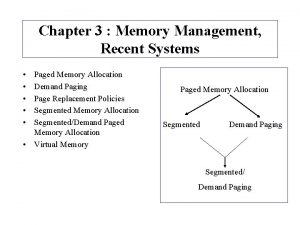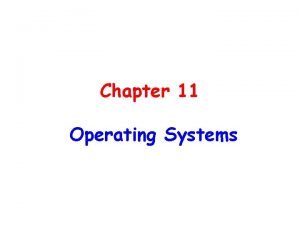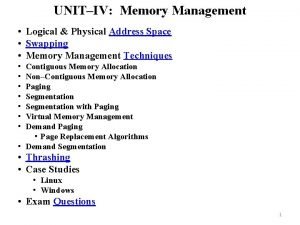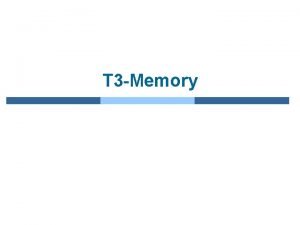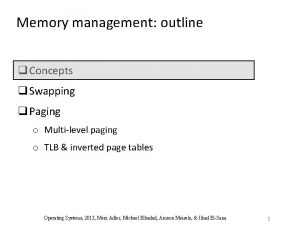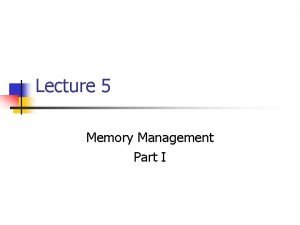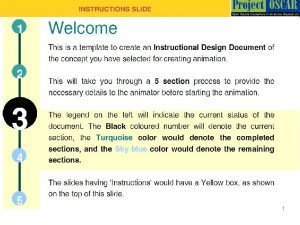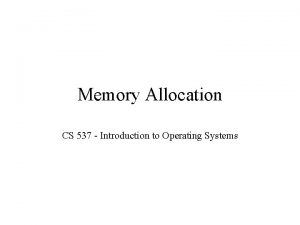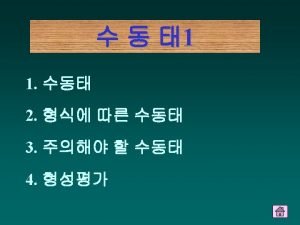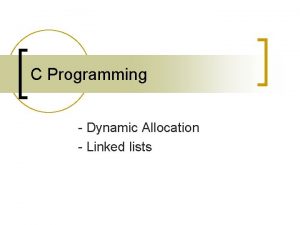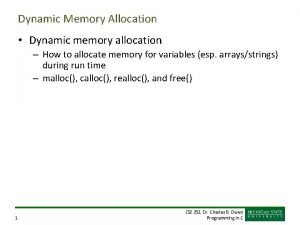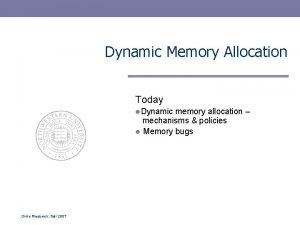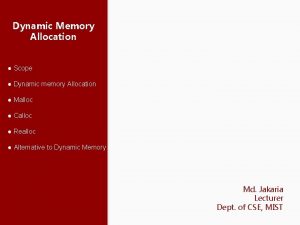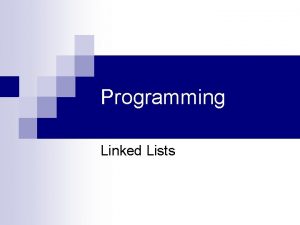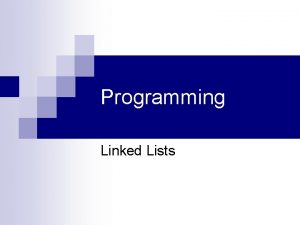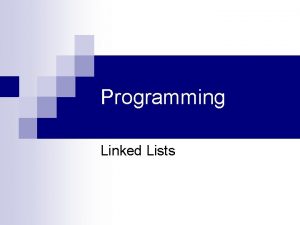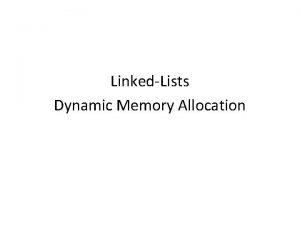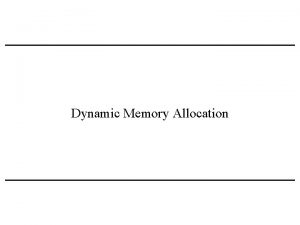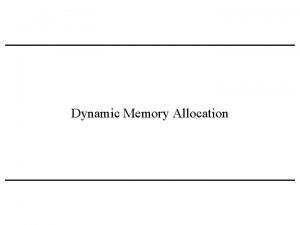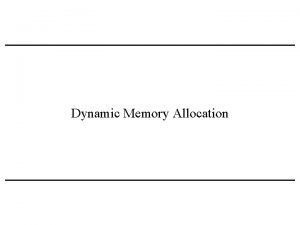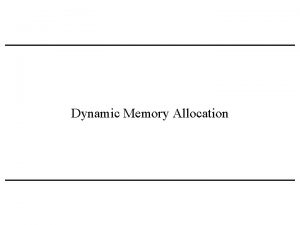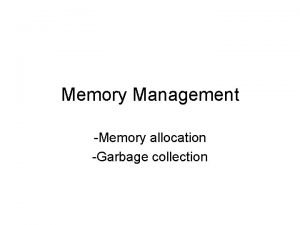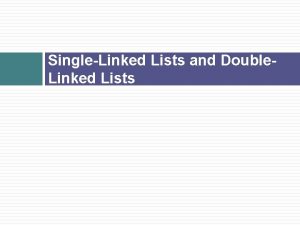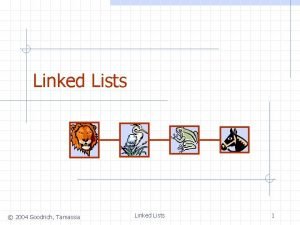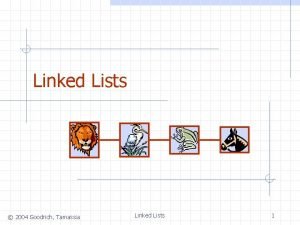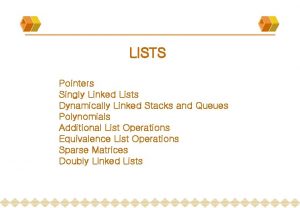Linked Lists Review Last week Dynamic memory allocation









































- Slides: 41

Linked Lists

Review Last week • Dynamic memory allocation two cases • Single instances (One thing) – atomic data (int char float) – structured data (structs and classes) • Arrays or blocks of things – atomic data – structured data (structs and classes)

Declaration of pointer • Pointer holds base address of object, consider. . struct my. Type { age; height; }; int * int. Ptr; //int. Ptr holds an address of an int my. Type * my. Type. Ptr; //my. Type. Ptr holds and address of //a my. Type

Ask for memory off Heap • One instance int. Ptr = new int my. Type. Ptr = new my. Type; • Array or block int. Ptr = new int[1000]; my. Type. Ptr = new my. Type[1000];

Dereference pointers • To access data referred to by the pointer • Case of simple atomic data, assuming y is an int. *int. Ptr = 8; y = *int. Ptr; • Case of structured data my. Type. Ptr->age = 10; my. Type. Ptr->height = 56;

Dereference Pointers • Case of array of simple atomic type for (i=0; i<n. Items; i++) int. Ptr[i] = 10; • Case of array of structured data for (i=0; i<n. Item; i++) my. Type. Ptr[i]. age = 10;

Releasing memory to prevent memory leaks • single instances delete int. Ptr; delete my. Type. Ptr; • arrays delete [] int. Ptr; delete [] my. Type. Ptr;

LINKED LISTS • Very important application of dynamic memory allocation

Linked List ADT • Is a dynamic data structure created using pointers. • They can grow and shrink according to need. • We have to specify all the operations that we have for array based lists.

Linked List ADT Data: – A linked lists contains nodes Operations: – Create list – Insert a node – Delete a node – Display list – Delete a list

Nodes • Contain a data field • Contain self reference (a pointer)

A Node struct mydata { int age; float height; }; struct Node { mydata; Node *next; }; Note reference to a node within node

Creating a Linked List struct List { int n. Nodes; Node * front; }; typedef Node * Node. Ptr; List A; Node. Ptr new. Node = NULL; A. front = NULL; //initialise “construct” A. n. Nodes = 0; // List A

After declaration of pointers A. front NULL new. Node NULL

Insertion to list new. Node = new Node; new. Node->data. age = 10; new. Node->data. height = 43. 5; new. Node->next = NULL; A. front NULL data->age new. Node data->height next 10 43. 5 NULL

Insertion to list A. front = new. Node; A. n. Nodes++; new. Node = NULL; A. front data->age data->height next new. Node NULL 10 43. 5 NULL

Insertion to list new. Node = new Node; //reuse pointer new. Node->data. age = 20; new. Node->data. height = 63. 5; new. Node->next = NULL; A. front data->age data->height next data->age new. Node data->height next 10 43. 5 NULL 20 63. 5 NULL

Insertion to list A. front->next = new. Node; A. n. Nodes++; new. Node = NULL data->age A. front data->height 10 43. 5 next data->age data->height next new. Node NULL 20 63. 5 NULL

Deletion from list (note requires another pointer) Deletion from front of list Node. Ptr current; current = A. front; data->age A. front data->height 10 43. 5 next current data->age data->height next 20 63. 5 NULL

A. front = A. front->next; A. n. Nodes--; data->age current data->height 10 43. 5 next data->age A. front data->height next 20 63. 5 NULL

delete current; current = NULL; current NULL data->age A. front data->height next 20 63. 5 NULL

Linked lists • They require very precise programming and a high level of understanding of manipulation of data by addresses. • Writing functions that manipulate linked lists also requires a very clear understanding of pointers. • This is HARD so take your time.

Non random access • An array allows us to go directly to any element • e. g. record data[5]; cout << data[3]. age; • With a linked list this is not possible you have to start at the beginning an visit each node before you move to the next node. • This is called traversing.

Summary • You need 3 structs defined – Data – Node that contains a pointer to Node – List that contains pointer to first Node • You need some pointers e. g – newnode. Ptr – Current – Previous • You need to declare a list (List A) • You need to dynamically get node memory and fill as you need. • You must then insert this into list (at front, end anywhere) carefully. • You must delete nodes carefully USE DIAGRAMS • To get to data you must traverse list

To traverse and display every Node //Traverse through whole linked list and display every record stop moving current = A. front; when no more while (current != NULL){ Nodes to go to cout << current->data. age << " “; cout << current->data. height << endl; current = current->next; } Visit Node…. . then…. . move to the next

Linked list Traversal current = A. front; while (current != NULL){ cout << current->data. age << " “; cout << current->data. height << endl; current = current->next; } A. front data->age data->height current 20 63. 5 next data->age data->height next data->age 30 data->height 3. 5 27. 5 data->age data->height next 50 data->age 60 83. 5 NULL 40 13. 5

Linked list Traversal current = A. front; while (current != NULL){ cout << current->data. age << " “; cout << current->data. height << endl; current = current->next; } A. front data->age data->height current 20 63. 5 next data->age data->height next data->age 30 data->height 3. 5 27. 5 data->age data->height next 50 data->age 60 83. 5 NULL 40 13. 5

Linked list Traversal current = A. front; while (current != NULL){ cout << current->data. age << " “; cout << current->data. height << endl; current = current->next; } A. front data->age data->height current 20 63. 5 next data->age data->height next data->age 30 data->height 3. 5 27. 5 data->age data->height next 50 data->age 60 83. 5 NULL 40 13. 5

Linked list Traversal current = A. front; while (current != NULL){ cout << current->data. age << " “; cout << current->data. height << endl; current = current->next; } A. front data->age data->height current 20 63. 5 next data->age data->height next data->age 30 data->height 3. 5 27. 5 data->age data->height next 50 data->age 60 83. 5 NULL 40 13. 5

Linked list Traversal current = A. front; while (current != NULL){ cout << current->data. age << " “; cout << current->data. height << endl; current = current->next; } current A. front data->age data->height 20 63. 5 next data->age data->height next data->age 30 data->height 3. 5 27. 5 data->age data->height next 50 data->age 60 83. 5 NULL 40 13. 5

Linked list Traversal current = A. front; while (current != NULL){ cout << current->data. age << " “; cout << current->data. height << endl; current = current->next; } A. front data->age data->height current 20 63. 5 next data->age data->height next data->age 30 data->height 3. 5 27. 5 data->age data->height next 50 data->age 60 83. 5 NULL 40 13. 5

Linked list Traversal current = A. front; while (current != NULL){ cout << current->data. age << " “; cout << current->data. height << endl; current = current->next; } A. front data->age data->height 20 63. 5 next data->age data->height next data->age 30 data->height 3. 5 27. 5 data->height next 50 data->age 60 data->height 83. 5 next current NULL 40 13. 5

Linked list Traversal current = A. front; while (current != NULL){ cout << current->data. age << " “; cout << current->data. height << endl; current = current->next; } A. front data->age data->height 20 63. 5 next data->age data->height next data->age 30 data->height 3. 5 27. 5 data->height next 50 data->age 60 data->height next current 83. 5 NULL 40 13. 5

Linked list Traversal current = A. front; while (current != NULL){ cout << current->data. age << " “; cout << current->data. height << endl; current = current->next; } A. front data->age data->height 20 63. 5 next data->age data->height next data->age 30 data->height 3. 5 27. 5 data->age data->height next 40 data->height 13. 5 next 50 data->age 60 83. 5 NULL current

Linked list Traversal current = A. front; while (current != NULL){ cout << current->data. age << " “; cout << current->data. height << endl; current = current->next; } A. front data->age data->height 20 63. 5 next data->age data->height next data->age 30 data->height 3. 5 27. 5 data->age data->height next 40 data->height 13. 5 next 50 data->age 60 83. 5 NULL current

Linked list Traversal current = A. front; while (current != NULL){ cout << current->data. age << " “; cout << current->data. height << endl; current = current->next; } A. front data->age data->height 20 63. 5 next data->age data->height next data->age 30 data->height 3. 5 27. 5 data->age data->height next data->height 40 13. 5 next 50 data->age 60 83. 5 NULL current

Linked list Traversal current = A. front; while (current != NULL){ cout << current->data. age << " “; cout << current->data. height << endl; current = current->next; } A. front data->age data->height 20 63. 5 next data->age data->height next data->age 30 data->height 3. 5 27. 5 data->age data->height next data->height 40 13. 5 next 50 data->age 60 83. 5 NULL current

Linked list Traversal current = A. front; while (current != NULL){ cout << current->data. age << " “; cout << current->data. height << endl; current = current->next; } A. front data->age data->height 20 63. 5 next data->age data->height next data->age 30 data->height 3. 5 27. 5 data->age data->height next data->height 40 13. 5 next 50 data->age 60 83. 5 NULL current

Traverse to Node n • To visit and display particular node say the 3 rd node in the list (n = 3). Assume that n. Nodes is greater than 3! • initialise current Node pointer to First Node current = A. front; //set current to first for (i=1; i<3; i++) { current = current->next; //move forward two } cout << current->data. age << " “; //current now at third cout << current->data. height << endl; DEMO 3

Tidy up code necessary • Use functions! – Create. List(List) – Add. Node(List, new. Node) – Delete. Node(List, N) – Delete. List(List) – Display. Node(List, N) – Display. List(List); Demo 4

Summary • You and remove one element at a time dynamically. • You therefore must know the syntax for de-referencing single instances of objects. • You must understand how to insert, delete nodes and traverse lists. • This technique is the basis for many advanced data structures – Trees, graphs, stacks, queues. • You need to understand structs functions pointers, loops, selection …thoroughly! • Take your time: look at the demo programs • Linked Lists require a high degree of precision. • Use diagrams to help you.
 Linked allocation
Linked allocation Example of dynamic memory allocation
Example of dynamic memory allocation Knuth's boundary tags
Knuth's boundary tags Advantages and disadvantages of dynamic memory allocation
Advantages and disadvantages of dynamic memory allocation Knuth’s boundary tags
Knuth’s boundary tags Example of dynamic memory allocation
Example of dynamic memory allocation Dynamic data structure
Dynamic data structure Dynamic memory allocation in data structure
Dynamic memory allocation in data structure Dma dynamic memory allocation
Dma dynamic memory allocation Pseudocode with functions
Pseudocode with functions Memory allocation in java
Memory allocation in java Calloc example
Calloc example In linked list the successive elements
In linked list the successive elements Difference between an array and a linked list
Difference between an array and a linked list Perbedaan single linked list dan double linked list
Perbedaan single linked list dan double linked list Dynamic strategies for asset allocation
Dynamic strategies for asset allocation Dynamic storage allocation problem
Dynamic storage allocation problem Polymorphism dynamic allocation
Polymorphism dynamic allocation Assumptions for dynamic channel allocation
Assumptions for dynamic channel allocation Dynamic storage allocation
Dynamic storage allocation Bandwidth ancoats
Bandwidth ancoats Buddy memory allocation
Buddy memory allocation Single contiguous memory management
Single contiguous memory management Paged segmentation
Paged segmentation Memory allocation policy
Memory allocation policy In contiguous memory allocation has no cure
In contiguous memory allocation has no cure Segmented/demand paged memory allocation
Segmented/demand paged memory allocation What are two goals of multitasking memory allocation
What are two goals of multitasking memory allocation Non contiguous memory allocation
Non contiguous memory allocation Non contiguous memory allocation
Non contiguous memory allocation Jihad
Jihad Non contiguous memory allocation
Non contiguous memory allocation Bitmap and linked list in os
Bitmap and linked list in os Memory allocation
Memory allocation Zig memory allocation
Zig memory allocation Memory allocation policy
Memory allocation policy Buddy system memory allocation
Buddy system memory allocation Week by week plans for documenting children's development
Week by week plans for documenting children's development Dynamic linked list
Dynamic linked list Answer the questions about your last weekend
Answer the questions about your last weekend What did your partner do last weekend
What did your partner do last weekend They broke the window last week
They broke the window last week
